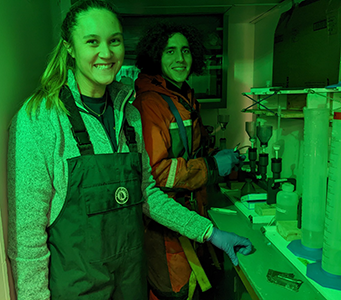Ashley Arroyo
October 4, 2022
Nimrod Rozen is an undergraduate student at the University of Victoria who is taking water samples for his senior research whilst aboard the Louis. Transparent exopolymer particles (TEPs) are gel-like polysaccharides produced by phytoplankton excretions that play a pivotal role in carbon cycling in the ocean. Namely, TEP is responsible for a significant downward flux of particulate organic carbon (POC) through its role as a ‘marine glue’ that binds together aggregates of marine snow.
Nimrod is interested in understanding the role of TEPs in context with carbon cycling in the Arctic Ocean, as well as their relationships to chlorophyll, POC, nutrient concentrations, and physical parameters of water (such as temperature and light availability). To address these questions, water samples of TEPs, chlorophyll, POC, nutrients (nitrate and phosphate), and dissolved oxygen are being collected alongside CTD and PAR (photosynthetically active radiation) data from casts. Nutrients and oxygen are being processed on board by researchers from the Institute of Ocean Sciences (IOS), Sarah-Ann Quesnel and Erinn Raftery, respectively. Onboard, chlorophyll and POC are being filtered through Glass Fiber Filters, and TEP is being filtered through a 0.4-micron polycarbonate filter. The TEP is subsequently stained with an addition of a calibrated blue dye, which binds with the acidic groups of TEP polysaccharides (sulfonic and carboxylic acids), and therefore the concentration of the dye bound onto the filter is proportional to the concentration of polysaccharides in the sample of water (which is determined colorimetrically using a UV-Vis spectrophotometer).
The results of this study will give insight into the spatial distribution of TEP concentrations in different types of Arctic Ocean environments (i.e., open ocean regions, coastal regions, regions with varying sea ice cover). We are all very excited to hear about the results of this study once the samples are processed in the lab at the University of Victoria after the expedition! As to what the rest of the science crew is up to, the Louis is making its way up the “BL line,” which refers to a group of science stations off the coast near Utqiagvik (formerly, Barrow), Alaska. These stations can be less than 10 km apart, so the science crew is keeping busy with CTD casts, bongo nets, and processing water samples.

